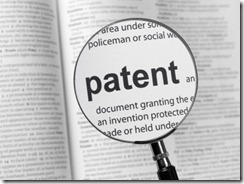In the first post we introduced the five key tactics to get more our of your intellectual property. This post focuses on patents.
A patent can be granted to anyone who “invents or discovers any new and useful process, machine, manufacture, or composition of matter, or any new and useful improvements.” The term “process” is defined as an act, method, or sequence of steps, and primarily includes industrial or technical processes. The term “manufacture” refers to articles that are made, and includes all fabricated articles. The term “composition of matter” refers to chemical compositions and may include mixtures of ingredients as well as new chemical compounds.
A patent is issued by the United States Patent & Trademark Office (USPTO) after a thorough review process to evaluate the newness and ensure that the invention has not been practiced before1. A patent allows the inventor the right to exclude others from making, using, offering for sale, or selling the invention in the United States. A patent also prohibits others from importing the invention into the United States. The term of a new patent is 20 years from the date the patent application was filed at the USPTO. Some older patents had 17 year terms. United States patents are effective only within the United States, US territories, and US possessions.
In order for an invention to be patented, it needs to be new and non-obvious to one skilled in the area of the invention. The term “prior art” entails any description, publication, or invention that or describes the proposed invention. According to the US Patent & Trademark Office, an invention cannot be patented if:
- The invention has been described in a printed publication anywhere in the world or has been in public use or on sale in the US before the date the applicant made their invention.
- The invention has been described in a printed publication anywhere in the world or has been in public use or on sale in the US for more than one year before the patent application filing date, regardless of the date the applicant made their invention.
Documenting the first date the invention was conceived is very important. To protect the invention date, the inventors should describe the invention in detail, then sign and date the description. Another person should read, understand, and witness the invention by signing and dating the written description. Ideally, all potential inventions should be recorded in lab notebooks that are filed for future reference.
In the United States, if the inventor describes the invention in a printed publication, uses the invention publicly, or offers the invention for sale, the inventor must apply for a patent within one year of the first disclosure or any right to a patent will be forfeited. If the inventor is seeking foreign patent rights, the patent application must be filed on or before the date of public use or disclosure to maintain patent rights in many foreign countries.
Even if the invention sought to be patented is not disclosed in the prior art, the subject matter must be new and different from what has been used or described before. The difference or improvement must also pass another hurdle. The invention must be non-obvious. This means that the invention must be sufficiently different from what has been disclosed in the prior art and that it may be said to be non-obvious to a person having ordinary skill in the subject area related to the invention. For example, changes of colors or sizes of products are generally not patentable. If changing the shape or form adds new and different functions or features, and if the changes are non-obvious, then the invention may be patentable. The prior art determination is usually fairly easy to determine after completing a comprehensive search. Consulting a patent attorney can help you determine if your invention passes the non-obvious requirement.


Leave a Reply